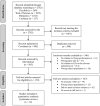A systematic narrative review of the involvement of executive functions in flying performance of pilots
- PMID: 39703619
- PMCID: PMC11656452
- DOI: 10.3389/fnrgo.2024.1462304
A systematic narrative review of the involvement of executive functions in flying performance of pilots
Abstract
Piloting is a complex task that demands robust cognitive functions to handle multiple tasks simultaneously in a constantly changing environment. As a result, cognitive abilities, particularly executive functions (EFs), have gained significant importance in relation to flight performance. However, the specific EFs most critical for predicting flight performance remain unclear. Understanding the exact nature of this relationship has the potential to advance research on pilot selection procedures, cockpit design, and influence cognitive training approaches to ultimately improve flight safety. This systematic review aims to pinpoint the most pertinent EFs for various aspects of airplane piloting. A systematic narrative literature review was conducted with a framework focusing on four EFs: working memory updating, set-shifting, response inhibition, and conflict monitoring, as well as three key aspects of flight performance: flying, navigating, and communicating. The findings suggest that multiple EFs predict flight performance outcomes. Notably, working memory updating significantly predicts the management of communication tasks and the making of critical decisions requiring mental flexibility. However, other specific EFs remain understudied. To advance this research area, we recommend conceptualizing EFs and flying measures based on existing theoretical frameworks, using measures sensitive to specific EFs, evaluating flying performance in simulated or real flights, controlling or accounting for factors that affect EFs and flying performance, and investigating the ameliorative potential of EFs with end results on flight performance.
Keywords: conflicting monitoring; inhibition; shifting; working memory updating; “fly-navigate-communicate”.
Copyright © 2024 Enriquez-Geppert, Smit, de Boer, Daneshnia, Lafont and Dehais.
Conflict of interest statement
The authors declare that the research was conducted in the absence of any commercial or financial relationships that could be construed as a potential conflict of interest. The author(s) declared that they were an editorial board member of Frontiers, at the time of submission. This had no impact on the peer review process and the final decision.
Figures
References
-
- Arce T. R., McMullen K. (2021). The Corsi Block-Tapping Test: Evaluating methodological practices with an eye towards modern digital frameworks. Comp. Hum. Behavior Reports. 4:100099. 10.1016/j.chbr.2021.100099 - DOI
-
- Baker S. P., Lamb M. W., Grabowski J. G., Rebok G., Li G. (2001). Characteristics of general aviation crashes involving mature male and female pilots. Aviat. Space Environ. Med. 72, 447–452. - PubMed
Publication types
LinkOut - more resources
Full Text Sources
Research Materials



